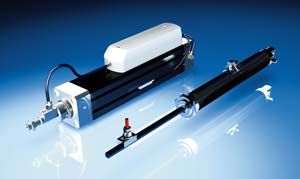
Posted to News on 24th Feb 2012, 14:25
Intelligent dampers provide dynamic control over damping
Albert Jagger is now supplying the Bansbach EasyERF Intelligent Dampers that feature electronic adjustment of the damping characteristics - with reaction times measured in milliseconds.

Combining smart PID systems and the latest in electrorheological fluid (ERF) technology, this autonomous system continuously monitors and modifies resistance forces within the damper. Achievable by digitally managing an electronic input signal to change the ERF fluid's viscosity within the damper, this innovative system offers instantaneous control of dynamic damping requirements with infinite adjustment possibilities.
Highly energy-efficient and with low power consumption (24V DC operation), the dampers can be adjusted using a variety of digital controls including 0-4V analogue, a standard PWM or a 24V DC logic controller (PLC). Described as 'silent' in operation, with no 'laminar flow' or 'whistling' noises, the control system has no moving parts to ensure maintenance-free operation.
With a wide adjustable range of forces between 100-2500N through strokes ranging from 25mm to a maximum of 125mm, accurate positioning is achievable to within 0.1mm.
Available through Bansbach's UK distributor, Albert Jagger, this range of intelligent dampers is claimed to be revolutionary. Initially developed for 'active suspension' systems within the top-marque automotive sector it was instantly recognised that this technology had a much broader scope of possibilities, particularly within industrial sectors involving machine suspensions, precise motion control actuators or self-adaptive end-of-stroke damping elements.
ERF technology explained

Smart PID (Proportional Integral Derivative) systems consist of at least one adjustable easyERF damping cylinder and one amplifier with an integrated controller. In its basic form this open-loop system involves manually managing the controller to modify the damping properties. For autonomous closed-loop systems, control measurement elements such as sensors can easily be integrated to measure parameters such as acceleration, displacement or weight. The possibilities here are limited only by the imagination of the design engineers.
Each easyERF system consists of a piston with a defined gap, known as the annular gap (see above), between the housing and piston and two chambers filled with silicon-based electrorheological fluid. With no electrical charge applied the fluid flows through an annular valve as in a standard damper. The inherent resistance is caused by the hydraulic drag coefficient of the laminar fluid flow. When an electrical charge is applied, the viscosity of the fluid increases, choking the annular valve and increasing the resistive force of the damper. A special feature of a smart PID system is that by increasing the electrical field to its maximum, the ERF solidifies to block mass movements, thereby achieving zero velocity or clamping.
Key advantages of using the Bansbach easyERF with smart PID Systems include:
- Continuous force control: There is a wide range between soft and hard damping characteristics, which can be adjusted at any point along the stroke.
- Dynamics of control: Smart PID Systems need only a few milliseconds to increase the damping force, so it is possible to control processes with high dynamics.
- Holding force: At velocity zero it is possible to clamp or block the ER damping cylinder by supplying an electrical field, similar to a friction clutch, thereby eliminating the need for other clamp elements.
- Remote control: Changing the damping characteristic can be done by an electrical signal, with no further mechanical adjustments required.
- Improved efficiency: Smart PID Systems only require a low power consumption (2-20W) when compared with other semi-active systems.
- Silent acoustics: There are no 'throttle' effects (no turbulence) inside the ER damping cylinder. In use the system is claimed to be absolutely silent.
- Durability: The easyERF damping cylinder is very robust and has no moving valve elements. The electronic components have a built-in fail-safe mode.
- Maintenance free: The electrorheological fluid remains undamaged by the ER effect.
Potential applications
One example could incorporate a slow-reading sensor typically found on conveyors to monitor weights. The weight of the load is transmitted to a computer, which calculates the electrical signal to send to the Bansbach easyERF damper that is acting as an end stop to arrest the loads movement. This would see a significant increase in productivity, as conveyor speeds are considerably increased because no human intervention is required to mechanically increase or decrease the end damper force.
A fast-reading example could involve a high-speed industrial centrifuge in which multiple vibration sensors monitor erratic vibrations within the machinery. This data is interpreted and passed to an array of easyERF dampers to damp out the machine's structural movements. These dampers would work independently of each other, with the computer sending different voltages to each damper simultaneously.
Here the centrifuge's efficiency and speeds can be significantly increased, as the Bansbach easyERF dampers prevent structural vibrations throughout the centrifuge acceleration and speed characteristics.
Albert Jagger says that this electrorheological technology offers completely new possibilities for the development of mechatronic systems. By incorporating Smart PID Systems it is possible to improve dramatically performance efficiencies of a diverse range of applications that could include: automated handling equipment such as conveyors, crushers, dryers or centrifuges; production machinery involved in drilling, forming, or milling; medical equipment such as exercise machines typically used in resistance training for heart attack patients or victims of congenital or acquired limb loss.
Follow the link to download a datasheet for the EasyERF Intelligent Dampers (153kB PDF) or contact Albert Jagger for more information.
Want the latest machine building news straight to your inbox? Become a MachineBuilding member for free today >>

















